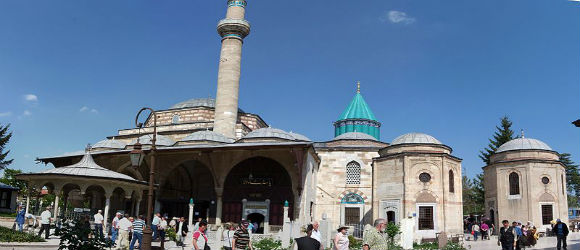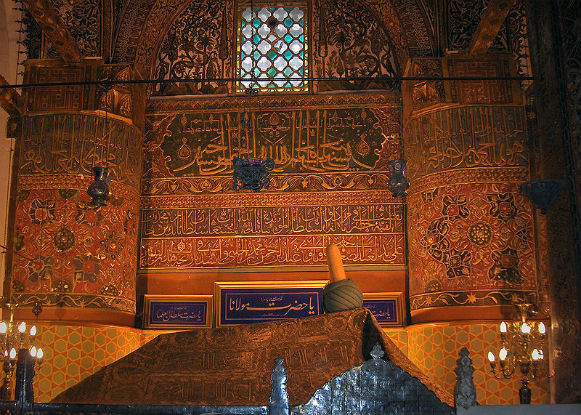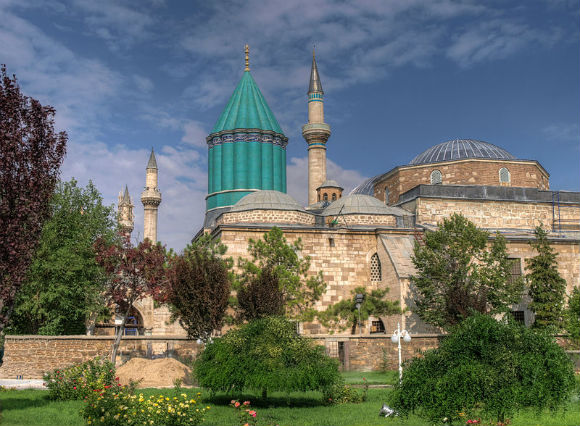The Mevlana Museum also known as the Green Mausoleum or Green Dome, is the original lodge of the Mevlevi Whirling Dervishes, a mystical Sufi Muslim group. It containes the tomb and shrine of the Mevlana, or Rumi, which remains an important place of pilgrimage.
History
Sultan ‘Ala’ al-Din Kayqubad, the Seljuk sultan who had invited Mevlana to Konya, offered his rose garden as a fitting place to bury Baha’ ud-Din Walad (or Bahaeddin Veled), the father of Mevlana, when he died in 1231. When Mevlana himself died on December 17, 1273, he was buried next to his father.
Mevlana’s successor Hüsamettin Çelebi built a mausoleum (Kubbe-i-Hadra) over the grave of his master. The Seljuk construction, under architect Behrettin Tebrizli, was finished in 1274. Gürcü Hatun, the wife of the Seljuk Emir Suleyman Pervane, and Emir Alameddin Kayser funded the construction.
The cylindrical drum of the of the dome originally rested on four pillars. The conical dome is covered with turquoise faience. Several sections were added until 1854. Selim I decorated the interior and performed the woodcarving of the catafalques.
A decree by Ataturk in September 1925 dissolved all Sufi brotherhoods in Turkey. On April 6, 1926, another decree ordered that the Mevlana mausoleum and dervish lodge be turned into a museum. The museum opened on March 2, 1927.
Special permission granted by the Turkish government in 1954 allowed the Mawlawi dervishes of Konya to perform their ritual dances for tourists for two weeks each year. Despite government opposition the order has continued to exist in Turkey as a religious body. The tomb of Rumi, although officially part of a museum, attracts a steady stream of pilgrims.
What to See
The dervish lodge (tekke) includes a semahane, where the ritual sema or whirling ceremony takes place, a sadirvan for ritual ablutions, a library, living and teaching quarters, and the mausoleum housing the tomb of Celaleddin Rumi, founder of the sect and later awarded the honorable title of Mevlana. His epitaph reads: “Do not seek our tombs on this earth – our tombs are in the hearts of the enlightened.”
The mausoleum room is highly ornamented with Islamic script and enameled reliefs, and contains the tombs of several of the more important figures of the dervish order. The main tomb enclosed behind a silver gate crafted in 1597 is that of Mevlana. The tomb of his father, Bahaeddin Veled, is upright and adjacent to his son’s, a position that signifies respect.
The adjoining room, or the semihane, is now a museum of Mevlana memorabilia displaying musical instruments and robes belonging to Mevlana, along with Selçuk and Ottoman objects like gold-engraved Korans from the 13th century. Among the fabulous ancient prayer rugs is the most valuable silk carpet in the world.
Mevlana Museum, Konya,




It is very interesting to visit such an important and spiritual place as Mevlana Museum is. You can see the tombs of the great philosoper and his fellows, both the exterior and interior of the building are a very fine exampleof ancient Selcuk arts. And furthermore, there are lots of hand made books of all array of dimension (even such…
I enjoyed our visit to the Mevlana Museum. The exhibits were interesting and well presented. It can get pretty crowded. The area housing the tomb of Rumi and others was very crowded with a mix of visitors from all over the world, many devout people praying and I felt a bit like we were intruding, but everyone was kind and…
This is a great place to get some insight on Sufism. Mevlana Museum is really interesting and gives info regarding the lives and history and the unique way of teachings of Rumi. This is the birthplace of the whirling dervishes and the mystic, Mevlana, better known as Rumi. Rumi was the one who created the whirling dervish dance; it’s a…
After mosques in Istanbul I was not very interested. It is not to everyones taste and rather run of the mill. Apparantly Mevlana is almost worshipped by many Turks although Attaturk banned the Dervishes, This place is called a museum becaus the movement is officially discouraged but it is in practice a place of worship.
There were renovations when we were there in November but it was amazing to see the how the dervishes lived. The grounds were well kept but the washrooms were filthy. My feet go wet through my shoes, and it was not raining!
When I decided to stop in Konya to visit the Mevlana Museum, I just couldn't imagine how much I was going to enjoy it. I went to discover more about Rumi and was pleasantly surprised by all the information displayed. The mausoleum was also very impressive. Definitely a must.
It was a privilege to visit Mevlana at his tomb at Konya. His work and writings will continue to inspire us all eternally
This place is the best in Konya and one of the first 10 in Turkey. For sure this is the place that must be visited first of all in line. You can find lots of information about Mevlana. Lots of books and old things, including cloths, flags, hats, ….. This place is a must.
For non believers, you will need to be very open minded to visit this museum as it feels more like a place for pilgrimage. Noted lots of people go there to pray and worship. Interesting to see what goes on around you. People are also very friendly.
Our guide actually gave us the Audio Guide during our visit, which turn…
Many rooms with displays of sufi life. The Mausoleum was filled with faithful. A ritual hall where the Sema was practiced.